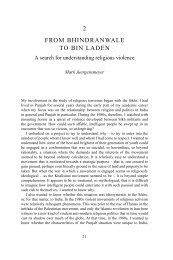New Glob Fu JFTR1275.pdf - Jan Nederveen Pieterse
New Glob Fu JFTR1275.pdf - Jan Nederveen Pieterse
New Glob Fu JFTR1275.pdf - Jan Nederveen Pieterse
You also want an ePaper? Increase the reach of your titles
YUMPU automatically turns print PDFs into web optimized ePapers that Google loves.
Author's personal copy<br />
716<br />
ARTICLE IN PRESS<br />
J. <strong>Nederveen</strong> <strong>Pieterse</strong> / <strong>Fu</strong>tures 40 (2008) 707–720<br />
sectors experience upturns while others experience downturns. A case in point is East Asia and China<br />
becoming growth poles in the world economy since the late twentieth century.<br />
Second, capitalism singular tends to downplay variations in capitalism over time. Capitalisms ‘golden<br />
years’, 1950–1973, combined economic growth with equity: inequality between and within countries decreased.<br />
Neoliberal capitalism, 1980–2000, produces radically different effects: polarizing growth or growth with<br />
growing inequality. But is not all of this ‘capitalism’?<br />
Kenichi Ohmae rejects the notion of an Asian model and argues that the characteristics of Asian companies<br />
reflect a stage of development rather than geography [34]. However, stages of development imply<br />
understanding capitalism in the singular; presumably in this reasoning in a more advanced stage Asian<br />
capitalism would resemble American capitalism.<br />
Third, capitalism singular downplays variations in capitalism by region. Yet, as Dani Rodrik notes, we have<br />
globalization but not global capitalism [35]. Variations in national institutions matter and the contest between<br />
capitalisms, between Anglo-American capitalism and other variants, is at issue worldwide and reverberates in<br />
development policies, business decisions, finance and geopolitics.<br />
Fourth, capitalism singular reinforces the cliché that ‘there is no alternative’. It upholds the ide´e fixe that<br />
neoliberalism, rather than a rightwing utopia, is ‘real capitalism’. Capitalism singular leads to a binary,<br />
polarizing approach that reproduces the old disputes between revolution and reform (revisiting Kautsky and<br />
Bernstein vs. Lenin, Luxemburg and Trotsky). Now, this takes the form of a false choice between<br />
neoliberalism and socialism. Anyone who works in development studies knows that these options are unreal.<br />
Neoliberalism is unworkable and socialism, in general, is not a realistic program.<br />
According to Wallerstein, the three main cleavages in twenty-first century globalization are rivalry within<br />
the triad (US, EU and Japan), the North–South divide in the global inequality, and the divide between the<br />
World Economic Forum and the World Social Forum, between Davos and Porto Alegre. In part, this can be<br />
understood as the interaction and contestation of different capitalisms. The latter rift is often interpreted as a<br />
choice between capitalism and socialism. I question this: the main divide now runs not between capitalism and<br />
socialism, but between capitalism and capitalism, or what kind of capitalism?<br />
Fifth, capitalisms, then, pose the question which capitalism—American, Scandinavian, Rhineland, Chinese<br />
etc.? This has the advantage of clearly posing the problem of future directions within societies rather than<br />
implicitly upholding American capitalism as the standard (in relation to which only socialism is an<br />
alternative).<br />
Sixth, capitalisms pose the question of the interaction of capitalisms as a core problem of globalization. The<br />
various capitalisms are intertwined through technology, knowledge, finance, investments, trade and<br />
international institutions. Thus, capitalisms plural draws attention to the terms of this interaction without<br />
posing one form of capitalism as the norm. Indeed, it has become difficult to uphold American capitalism as<br />
the norm because it now relies on cheap Asian imports and Asian vendor financing.<br />
The calls for structural reform in Japan and Europe stem from the belief that the Americans and the other<br />
‘Anglo-Saxon’ economies have the sort of flexibility that breeds success. Yet that hardly squares with the<br />
IMF’s notion that the US economy could be going down the pan at any moment. [36].<br />
Modernities and capitalisms also point to globalizations: each modernity and each capitalism pursues its<br />
preferred mode of globalization [37]. Modernities and capitalisms concern different ways of navigating<br />
different modes of regulation and types of economic and social organization and different ways of analyzing<br />
them. Beyond ‘emerging powers’ they pose the question emerging on what terms? Beyond the ‘rise of Asia’<br />
they pose the question what kind of Asia, what kind of capitalism, what kind of modernity? Growth obsessed,<br />
consumerist, authoritarian, polluting? Fast track tycoon capitalism, or development that balances growth,<br />
equity and sustainability? A sociological approach means placing the analysis of the balance of forces center<br />
stage.<br />
However, this discussion takes place in a battlefield of paradigms, an arena in which few statistics, diagnoses<br />
and policies are ideologically neutral. Economic success and failure do not come with radio silence, but are<br />
immersed in ideological noise and filtered through representations. The World Bank claimed the ‘East Asian<br />
miracle’ as evidence of the wisdom of its policies of liberalization and export-led growth, while for Japan it<br />
showed the virtues of capable government intervention [38]. According to Alan Greenspan, the Asian crisis of<br />
1997 demonstrated that Anglo-American capitalism was the only viable economic model. China’s economic





